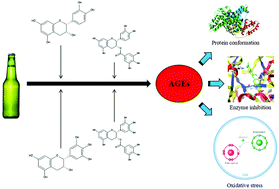The inhibitory effect of the catechin structure on advanced glycation end product formation in alcoholic media
Abstract
Advanced glycation end products (AGEs) and their important intermediate products (α-dicarbonyl compounds) that are generated by the Maillard reaction are closely related to diabetes. Our study first investigated the mechanisms of the anti-glycation effects of epicatechin (EC), (−)-epicatechin gallate (ECG), (−)-epigallocatechin (EGC), and (−)-epigallocatechin gallate (EGCG) in an alcoholic environment. The results showed that catechins played an important role in the inhibition of AGE formation, and the effect of EC was the best. Their corresponding mechanisms included total antioxidant capacity (TAOC), 1,1-diphenyl-2-picrylhydrazyl (DPPH) scavenging ability, trapping of methylglyoxal (MGO), protection of the protein structure, and inhibition of the activities of α-amylase, α-glucosidase, and β-glucosidase, which were consistent with the study of molecular docking. This study will offer a theoretical basis for the applications of different types of catechins to alcoholic beverages as natural AGE formation inhibitors.



 Please wait while we load your content...
Please wait while we load your content...